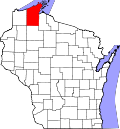Sioux, Wisconsin | |
|---|---|
| Coordinates: 46°44′14″N90°52′49″W / 46.73722°N 90.88028°W | |
| Country | |
| State | |
| County | Bayfield |
| Town | Bayview |
| Elevation | 607 ft (185 m) |
| Time zone | UTC-6 (Central (CST)) |
| • Summer (DST) | UTC-5 (CDT) |
| Area codes | 715 and 534 |
| GNIS feature ID | 1577823 [1] |
Sioux is an unincorporated community located in the town of Bayview, Bayfield County, Wisconsin, United States. [1]
This community was named after the Sioux people. [2]


